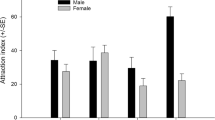Abstract
The Japanese horned beetle, Trypoxylus dichotomus septentrionalis, usually aggregates at the wounds caused by boring insects on Quercus oak trees to feed on exuding sap. Here, a unique behavior of the beetle, which enables it to independently obtain sap without any activities of other insects, is reported. Beetles carved intact bark of Fraxinus griffithii, where no sap was exuding, using clypeus. As a result of carving behavior, bark was stripped, and sap exuded from these scars temporarily, which beetles immediately began to lick. A digital video image relating to the article is available at (http://www.momo-p.com/showdetail-e.php?movieid=momo050525td01a).





Similar content being viewed by others
References
Alcock J (2001) Animal behavior: an evolutionary approach. 7th edn. Sinauer Associates, Sunderland
Eberhard WG (1979) The function of horns in Podischnus agenor (Dynastinae) and other beetles. In: Blum MS, Blum NA (eds) Sexual selection and reproductive competition in insects, Academic Press, New York, pp 231–258
Hongo Y (2003) Appraising behaviour during male–male interaction in the Japanese horned beetle Trypoxylus dichotomus septentrionalis (Kono). Behaviour 140:501–517
Kitamura S, Murata G (1971) Coloured illustrations of woody plants of Japan. vol I. Hoikusha, Osaka (in Japanese)
Kurosawa Y (1985) Siiphidae. In: Ueno S, Kurosawa Y, Sato M (eds) The coleoptera of Japan in color. vol II. Hoikusha, Osaka (in Japanese)
Ochi T (1985) Scarabaeidae. In: Ueno S, Kurosawa Y, Sato M (eds) The coleoptera of Japan in color. vol II. Hoikusha, Osaka (in Japanese)
Siva-Jothy MT (1987) Mate securing tactics and the cost of fighting in the Japanese horned beetle Allomyrina dichotoma L. (Scarabaeidae). J Ethol 5:165–172
Suzuki T (2003) Ecology of Trypoxylus dichotomus is different among habitats. Kuwagata Mag 13:28–33 (in Japanese)
Yoshimoto J, Nishida T (2004) The effects of carpenterworm (Lepidoptera: Cossidae) on tree sap exudate and the attracted insect community. Abstr. 48th annual meeting Appl Ent Zool, Kyoto, 32 pp. (in Japanese)
Yoshimoto J, Kakutani T, Nishida T (2005) Influence of resource abundance on the structure of the insect community attracted to fermented tree sap. Ecol Res 20:405–414
Acknowledgements
I thank Drs. A. Mori and K. Yoda for their helpful comments on the manuscript. I am grateful to Dr. S. Cook for his English corrections. Field observation was conducted under the permission of Kamigamo Experimental Station of Field Science Education and Research Center, Kyoto University. This study was supported in part by a Grant for the Biodiversity Research of the 21st Century COE (A14).
Author information
Authors and Affiliations
Corresponding author
About this article
Cite this article
Hongo, Y. Bark-carving behavior of the Japanese horned beetle Trypoxylus dichotomus septentrionalis (Coleoptera: Scarabaeidae). J Ethol 24, 201–204 (2006). https://doi.org/10.1007/s10164-006-0202-x
Received:
Accepted:
Published:
Issue Date:
DOI: https://doi.org/10.1007/s10164-006-0202-x



